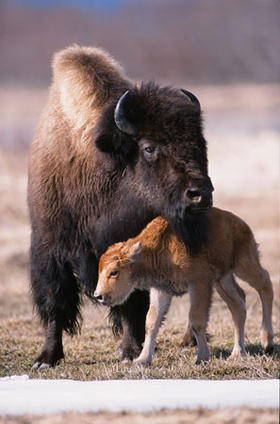
Russian scientists have purchased yearling bison from a Delta Junction area ranch that are headed to Pleistocene Park, a 20-square-kilometer research plot in eastern Siberia. Nikita Zimov and his father Sergey are trying to recreate an ice age ecosystem.
“We know that main four species were mammoths, bison, horse and reindeer. And bison were actually the most dominant,” Nikita Zimov said.
A dozen bison are set to be transported as part of the geo-engineering project. The bison are central to the experiment to see if herd animals can help prevent melting of carbon rich permafrost.
“Animals when they forage trample down the snow,” Zimov said. “So when animals trample down the snow, they allow this cold to penetrate, and then the winter soils freeze much deeper.”
The Alaska bison will complement horses, musk oxen, reindeer and yaks the Zimovs previously transplanted to Pleistocene Park.
Zimov said grasses that proliferate on trammeled earth reflect more sunlight, store more carbon, and dry underlying soils, reducing production of the powerful greenhouse gas methane. It’s a small scale exercise with potentially global implications, and worth pursuing, according to ecologist Terry Chapin of Fairbanks.
“It takes the actual experiment to determine what the outcome will be. And I think that’s the value of Pleistocene Park.”
Chapin, an accomplished researcher of the ecological impacts of climate change, has visited the park, knows the Zimovs and is helping with the effort to transport the bison.
“They’re going to build the crates that’ll carry the bison. And they’re going to build those in our garage,” Chapin said. “And an 11-month old bison is, like, bigger that you would expect. They weigh about 500 pounds. They don’t like to be confined so they’re difficult to deal with. They’re kind of like little furry Tasmanian devils with horns.”
Luke Griswold Tergis of Haines is making a documentary about Pleistocene Park, and handling a lot of the Alaska side logistics. He connected Zimov with the Stevens Village bison farm near Delta Junction.
“As a favor, I was like, ‘Oh, you know, Nikita — let me — I’ll just call some people in Alaska and see if anyone has any bison for sale,” he said.
Ben Stevens with Tanana Chiefs Conference said he knew right away he could probably help. He said he feels good about tribally raised bison going to Pleistocene Park.
“Because it’s restoring an animal to the wild,” Stevens said.
The bison are quarantined in preparation for travel to Siberia. Zimov doesn’t have a set a departure date, but has early June in mind at the latest.
Zimov said he’s working to secure an air carrier to fly the bison to Siberia, and raising money online to cover the remaining half of the $200,000 project cost.
